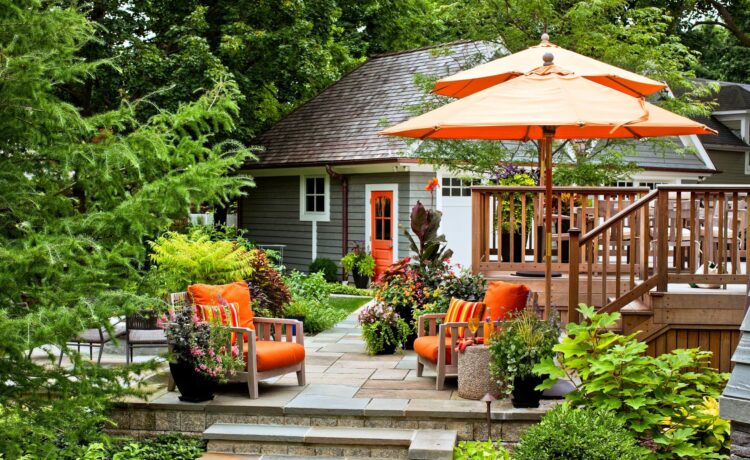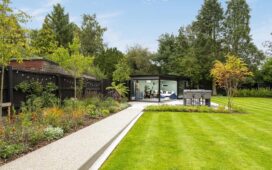Generally, backyard landscaping is an important crossroads of aesthetic desires and environmental utility, converting mundane yards into an extension of individual homes. By carefully designing and implementing these spaces, they become an extension of our houses and reflect our lifestyle needs and architectural and design principles.
What Makes Professional Design Process Different
The process of professional backyard landscaping starts with knowing the space dynamics and the environmental factors. Every landscape design potential is an opportunity to provide unity between manmade construction and natural features according to site-specific elements like regional weather conditions, existing greens and structures. This all-encompassing method will ensure that not only does every single backyard layout appear beautiful, but they also work and complete the intended functions effectively.
Site Analysis and Planning
Before they begin any physical work, professional landscapers conduct extensive site analyses to understand existing conditions and opportunities. This critical step assesses factors like the quality of your soil, the patterns of drainage in your yard, how much sunlight your yard gets, and what plants already grow there. By evaluating these components, a designer can create solutions that play off natural site conditions and become a more sustainable and manageable outdoor environment.
Components of a Good Professional Backyard Design
Spatial Organisation
In backyard design, professional landscape architecture projects show how helpful it is to think carefully about spatial organisation. You design different activity areas while ensuring flow and connection throughout the space. From designing spaces for gatherings, recreation, or everyday use, the overall layout within these areas plays a key role in how individuals interact with and experience their outdoor spaces.
Selection of the material and its implementation
Backyard landscaping is greatly dependent on the materials chosen. Professional designers select materials that work for the architectural style of the home as well as, the natural environment. Still, they also consider practical aspects such as durability and maintenance needs. Every material, from paving choices to timber selections, plays a role in the overall look and feel of the space.
Natural Elements Integration
Plant Selection and Placement
The principles of professional landscaping solutions focus on the proper choice of plants and optimal distribution. This process includes selecting plant species adapted to local climate and plant community conditions, which can contribute towards other site design goals such as providing shade, visual separation, and seasonal colour. Excellent landscape architecture projects showcase how careful plant choice can form engaging outdoor spaces that grow and develop as they age.
Whether small ponds or larger fountains and pools, water features can act as a sculptural centrepiece while influencing sound, a key sensory factor in backyard design. Professional designers consider sound, movement and reflection when bringing in water elements, ensuring that these aspects complement rather than overshadow the landscape. Implementing natural systems like rain gardens and bioswales can help manage water resources and provide an aesthetic value.
Functional Outdoor Living Spaces
Entertainment Areas
Contemporary landscaping trends for the backyard often centre on making flexible spaces for entertaining that function as an extension of indoor living space. Professional designers plumb circulation patterns, seating arrangements and weather protection when developing these spaces. Well-executed landscape architecture projects illustrate how outdoor rooms can be achieved through thoughtful positioning of building elements, plantings, and other design components.
Private Retreat Spaces
Individual spaces for relaxation and contemplation make a more miniature backyard landscape feel more significant. Due to the nature of larger backyard designs, personal little spaces often make them extra special. As with many garden design techniques, they can be employed by professional designers in various scenarios — from planting strategically to thoughtful placement of structural elements. Quiet spaces are vital because they serve as a contrast to the more active parts of the garden.
Sustainable Design Practices
Environmental Considerations
Landscape designs that are eco-friendly and do not harm the environment but maximise land use and other resources are increasingly leading in professional backyard landscaping. This considers the water use, the type of materials needed, and maintenance. Almost all landscape architecture projects prioritise innovative solutions to shaping beautiful outdoor spaces without being environmentally irresponsible.
Climate-Responsive Design
Great backyard designs accommodate local climate patterns to ensure outdoor areas are comfortable year-round. Professional designers consider things like the angles of sunfall, prevailing winds and seasonal changes when crafting a solution in a landscape. This adaptive methodology protects outdoor spaces to provide functionality and comfort regardless of the season.
Technical Implementation
Construction Documentation
Electronic plan sets of professional landscape architecture projects are necessary to implement a design successfully. This domain encompasses technical drawings, specifications, and construction details — documents that inform the actual physical manifestation of design ideas/copyleft. Good documentation helps ensure the final landscape mirrors the intended design while complying with all relevant codes and requirements.
Project Management
Effective project management is a significant factor in successfully implementing backyard landscaping. Professional designers oversee all those construction parts, from earthworks and drainage installation to planting and finishing details. This synergistic process ensures the streamlining of projects while ensuring quality across the entire construction journey.
Quality Control
Commercial landscaping projects are completed with more facility and are usually done with careful consideration in terms of quality and detail. This entails thorough preparation of soil and surfaces, precisely installing elements, and finishing work or design tasks. Consistent examination and evaluation during execution guarantees that the project conforms to its degree of professionalism.
Documentation and Communication
Communicating clearly and documenting everything throughout the design and construction journey helps ensure successful projects. Professional designers document decisions, changes and implementations while keeping the client updated on progress and any required adjustments to the original plan.
Beyond the Backyard: Design Trends for the Coming Years
Technological Integration
With technological advancements, landscape architecture practices are becoming more technical, with architectural elements adding value to functionality and experience. Applications range from automated irrigation systems to smart lighting controls, creating more efficient and enjoyable outdoor spaces while simplifying maintenance requirements.
Adaptive Design Strategies
Backyard landscaping in the backyard evolves with time, too, facing adaptive design challenges that continually impact its environmental sustainability and capacity to accommodate lifestyle changes. This long-term view helps keep landscapes relevant and valuable, evolving with future needs and opportunities.
Thanks to a careful mix of artistry and practical on-the-ground implementation, professional backyard landscaping creates outdoor space that directly impacts property value and the quality of life for those who inhabit the home. However, with thought-out design principles, environmental influences, and user requirements, landscape architects and professional designers have developed ordinary residences to become terrific exterior areas. When planning, designing, and constructing functional, beautiful, and sustainable landscapes, thoughtful planning and professional execution, maintenance, and care lead to landscapes that will provide enjoyment for years to come whilst being sustainable and manageable.






